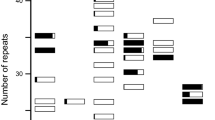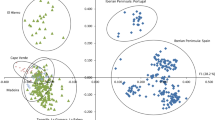Abstract
The genetic diversity ofP. lunatus in the Yucatan Peninsula was assessed on the basis of its morphological and phenological characters. Our results were then discussed in relation to ethnobotanic information obtained about the intraspecific diversity recognized by farmers, their selection criteria, agronomic management, production purpose and percentage of cultivated area. Research was undertaken in one of the cultural subareas of Mesoamerica, the Lowland Maya area, where traditional agriculture has been more persistent and where high diversity ofP. lunatus landraces has been recorded. Four of the 13 cultural-geographic zones established for the origin of this culture were included, 160 farmers from 12 localities were interviewed, and 149 seed samples ofP. lunatus germplasm were collected and analyzed using six characters. A subset of these samples was grown under ex situ uniform growth conditions and analyzed using 28 characters. Ethnobotanical and morpho-phenological data indicated 30 putative distinct landraces, two wild, and two weedy variants, suggesting gene flow among them. Richness and diversity estimates were greatest, and evenness lowest, where there was: 1) minimal agricultural intensification, 2) wild and weedy populations, and 3) greater persistence of traditional culture. Results underscored the importance of establishing in situ conservation programs in these areas.
Se estimó la diversidad genética deP. lunatus en la Península de Yucatán con base en caracteres fenológicos y morfológicos, y se discute en relatión a la informatión etnobotánica obtenida acerca de la diversidad intraespecífica reconocida por los campesinos, sus criterios de selectión, su manejo agronómico, el destino de la productión y el porcentaje de área cultivada. La investigation se llevó a cabo en una de las subáreas culturales de Mesoamérica en donde la agricultura traditional ha sido más persistente y en donde se ha reportado alta diversidad de cultivares deP. lunatus: las Tierras Bajas Mayas. Cuatro de las trece zonas geográfico-culturales establecidas en el origen de esta civilizatión fueron incluídas, 160 campesinos de 12 localidades fueron entrevistados y 149 muestras de semilla del germoplasma deP. lunatus fueron analizadas con base en 6 caracteres. Un subconjunto de estas muestras se cultivó bajo condiciones homogéneas de crecimiento ex situ y se analizó usando 28 caracteres. Los datos morfólogicos y etnobotánicos indicaron 30 cultivares putativos, dos variantes silvestres y dos arvenses, y sugirió flujo génico entre ellas. La riqueza y la diversidad fue mayor, y el predominio menor, donde hubo: 1) menor intensification agrícola, 2) poblaciones silvestres y arvenses deP. lunatus, y 3) mayor persistencia de cultura traditional. Los resultados resaltan la importancia de establecer programas de conservación in situ en estas áreas.
Similar content being viewed by others
Literature Cited
Adams, R. E. W., and T. P. Culbert. 1977. The origins of civilization in the Maya lowlands. Pages 3–34 in R. E. W. Adams, ed., The origins of Maya civilization. University of New Mexico, Albuquerque.
Allard, R. W. 1954. Natural hybridization in lima beans in California. Proceedings of the American Society for Horticultural Science 64:410–416.
— 1963. An additional gametophyte factor in the lima bean. Zürcher 33:212.
Ballesteros, G. A. 1999. Contribuciones al conocimiento del frijol Lima (Phaseolus lunatus L.) en América Tropical. Ph.D. dissertation, Colegio de Posgraduados. Montecillos, Estado de México.
Bartolomé, M. A., and A. M. Barabas. 1977. La resistencia Maya. Relaciones interétnicas en el Oriente de la Península de Yucatán. No. 53. Colección Científica. Etnología. Institute Nacional de Antropología e Historia. México D. F.
Baudet, J. C. 1977. The taxonomic status of the cultivated types of lima bean (Phaseolus lunatus L.). Tropical Grain Legume Bulletin 7:29–30.
Baudoin, J. P. 1993. Lima bean (Phaseolus lunatus L.). Pages 391–403 in G. Kalloo and B.O. Bergh, eds., Genetic improvement of vegetable crops. Pergamon Press, Oxford, UK.
Beebe, S., O. Toro Ch., A. Viviana G., M. I. Chacón, and D. G. Debouck. 1997. Wild-weed-crop complexes of common bean (Phaseolus vulgaris L., Fabaceae) in the Andes of Peru and Colombia, and their implications for conservation and breeding. Genetic Resources and Crop Evolution 44:73–91.
Bellon, M. R. 1996. The dynamics of crop infraspecific diversity: A conceptual framework at the farmer level. Economic Botany 54:26–39.
Bemis, W.P. 1959. Selective fertilization in lima beans. Genetics 44: 555.
Caicedo, A. L., E. Gaitán, M. C. Duque, O. Toro Chica, D. G. Debouck, and J. Tohme. 1999. AFLP fingerprinting ofPhaseolus lunatus L. and related wild species from South America. Crop Science 39:1497–1507.
CIAT. Centra Internacional de Agricultura Tropical. 1983. Etapas de desarrollo de la planta de frijol común. Centra Internacional de Agricultura Tropical. Cali, Colombia.
-. 2003. Data base of plant genetic resources. http://ciat.cgiar.org/urg/beans.htm.
Colunga-GarcíaMarín, P., and F. May-Pat. 1992. El sistema milpero y sus recursos genéticos. Pages 97–134 in D. Zizumbo V., C. H. Ramussen, L. M. Arias R. and S. Terán C., eds., La modernización de la milpa en Yucatán: Utopía o realidad. CICY-DANIDA. Mérida, Yucatán, México.
—,E. Estrada-Loera, and F. May-Pat. 1993. Patterns of morphological variation, diversity, and domestication of wild and cultivated populations ofAgave in Yucatan, Mexico. American Journal of Botany 83:126–140.
Colunga-GarcíaMarín, P., G. Campos-Rios, and S. Escalante-Rebolledo. 1990. El Jardín Botánico Regional del Centro de Investigatón Científica de Yucatán, México. No. 1. May. Latin American Botanic Gardens Bulletin. Botanic Gardens Conservation Secretariat.
—,R. Ruenes-Morales, and D. Zizumbo-Villarreal. 2003. Domesticatión de plantas en las tierras bajas mayas y recursos filogenéticos disponibles en la actualidad. Pages 116–127 in P. Colunga-GarcíaMarín and A. Larqué-Saavedra, eds., Naturaleza y sociedad en el area Maya: pasado, presente y futuro. Academia Mexicana de Ciencias-CICY.
Debouck, D. G. 1979. Proyecto de recolección de germoplasma dePhaseolus en México. CIAT-INIA, Centro de Internacional de Agricultura Tropical (CIAT), Colombia.
Duch-Gary, J. 1991. Fisiografía del estado de Yucatan. Su relatión con la agricultura. Universidad Autonoma de Chapingo. Texcoco, Mexico.
Erickson, H. T. 1982. Lima bean legacy. Hort Science 17:702.
FAO/UNESCO. 1972. Mapa mundial de suelos. Hoja III. México y América Central. UNESCO, Paris.
Fofana, B., P. du Jardin, and J. P. Baudoin. 2001. Genetic diversity in the lima bean (Phaseolus lunatus L.) as revealed by chloroplast DNA (cpDNA) variations. Genetic Resources and Crop Evolution 50:1–9.
—,X. Vekemans, P. du Jardin, and J. P. Baudoin. 1997. Genetic diversity in lima bean (Phaseolus lunatus L.) as revealed by RAPD markers. Euphytica 95:157–165.
Harlan, J. R. 1992. Crops and man. 2d ed. American Society of Agronomy and Crop Science Society of America, Madison, WI, USA.
Hernández, F. C., and S. A. Delgado. 1992. Recursos genéticos de frijoles en el oriente de Yucatán. Pages 147–160 in D. Zizumbo V., C. H. Ramussen, L. M. Arias R. and S. Terán C, eds., La modernización de la milpa en Yucatán: Utopía o realidad. CICY-DANIDA. Mérida, Yucatán, México.
Hernández-Xolocotzi, E. 1959. La agricultura. Pages 1–38 in E. Beltrán, ed., Los recursos naturales del sureste y su aprovechamiento. Vol. 3. Instituto Mexicano de Recursos Naturales Renovables. México, D. E
— 1970. Apuntes sobre la exploratión etnobotánica y su metodología. Colegio de Postgraduados. Escuela Nacional de Agricultura. Chapingo, México.
— 1992. Racionalidad tecnológica del sistema de productión agnićola de roza-tumba-quema en Yucatan. Pages 187–194 in D. Zizumbo V., C. H. Ramussen, L M. Arias R. and S. Terán C., eds., La modernización de la milpa en Yucatán: Utopía o realidad. CICY-DANIDA. Mérida, Yucatán, México.
IBPGR Secretariat. 1982. Lima bean descriptors. International Board for Plant Genetic Resources. Roma, Italy.
Lioi, L., and I. Galasso. 2002. Oligonucleotide DNA fingerprinting revealing polymorphism inPhaseolus lunatus L. Genetic Resources and Crop Evolution 49:53–58.
—,C. Lotti, and I. Galasso. 1998. Isozyme diversity, RFLP of the rDNA and phylogenetic affinities among cultivated lima beans,Phaseolus lunatus (Fabaceae). Plant Systematics and Evolution 213:153–164.
Luder, G. and Ch. Plummer. 2003. Vegetables and melons outlook. Electronic Outlook Report from the Economic Research Service. USDA. VGS-298. August, http://www.ers.usda.gov/publications/vgs/ aug03/vgs298.pdf
Makie, W. W. 1943. Origin, dispersal and variability of the lima bean,Phaseolus lunatus L. Hilgardia 15:1–29.
Maquet, A. 1991. Lima bean (Phaseolus lunatus L.) catalogue. Working document No. 80. Centra Internacional de Agricultura Tropical (CIAT). Cali, Colombia.
Maquet, A., I. Zoro Bi, M. Delvaux, B. Wathelet, and J. P. Baudoin. 1997. Genetic structure of a lima bean base collection using allozyme markers. Theoretical and Applied Genetics 95:980–991.
McAleece, N. 1997. Biodiversity professional beta. The Natural History Museum and The Scottish Association for Marine Science.
Miller, R. G., Jr. 1981. Simultaneous statistical inference. Springer-Verlag, New York.
Nahal, J. L. 1993. Reproducción y caracterización de 30 genotipos de frijoles ibes (P. lunatus L.) y botiles (P. coccineus L. yP. polyanthus Green) de Yucatán y Chiapas. Instituto Tecnológico Agropecuario No. 19, Tizimin, Yucatán, México.
Nienhuis, J., J. Tivang, P. Skroch, and J. B. dos Santos. 1995. Genetic relationships among cultivars and landraces of lima bean (Phaseolus lunatus L.) as measured by RAPD markers. Journal of American Society Horticultural Science 120:300–306.
Orellana, R., M. Balam-Ku, I. Bañvelos-Robles, E. Garcia, J. A. González-Iturbe, F. Herrara-Cetina, and J. Vidal-López. 1999. Evaluación climática. Pages 163–182 in A. García de Fuentes, J. Córdoba y Ordoñez, and P. Chico Ponce de León, eds., Atlas de Procesos Territoriales de Yucatán. Universidad Autónoma de Yucatán, Mérida, Yucatán.
Papa, R., and P. Gepts. 2003. Asymmetry of gene flow and differential geographical structure of molecular diversity in wild and domesticated common bean (Phaseolus vulgaris L.) from Mesoamerica. Theoretical and Applied Genetics 106:239–250.
Pérez-Toro, A. 1945. La agricultura milpera de los mayas de Yucatán. Pages 173–204 in L. H. Hoyos-Vilanueva, R. Irigoyen-Rosado, R. Ruz-Menéndez and H. Lara-Lara, eds., Enciclopedia Yucatanense. Vol. 6. Oficial Edition of Government of Yucatán State.
SAS. 1997. SAS/STAT user’s guide, release 6.12 edition. SAS Institute Inc., Cary, NC.
Shannon, C. E., and W. Weaver. 1949. The mathematical theory of communication. University of Illinois Press, Urbana, IL.
Simpson, E. H. 1949. Measurement of diversity. Nature 163: 688.
Vargas E. M., G. Macaya, J. P. Baudoin, and O. J. Rocha. 2001. Case studies on breeding systems and its consequences for germplasm conservation. 3. Electrophoretic mobility of phaseolins in wild populations of Lima beans (Phaseolus lunatus L.) in the Central Valley of Costa Rica. Genetic Resources and Crop Evolution 48:109–120.
Zar, J. H. (1999). Biostatistical analysis. 4th ed. Prentice Hall, Upper Saddle River, NJ.
Zizumbo-Villarreal, D. 1992. Conclusiones Mesa Redonda. La modernizatión de la milpa en Yucatán. Utopía o realidad. Pages 371–378 in D. Zizumbo V, C. H. Ramussen, L. M. Arias R. and S. Terán C., eds., La modernización de la milpa en Yucatán: Utopía o realidad. CICY-DANIDA. Mérida, Yucatán, México.
-Zizumbo-Villarreal, D., P. Colunga-GarcíaMarín, and P. Gepts. Riesgos de plantas transgénicas: el caso del frijol comun (Phaseolus vulgaris L.) en su centro de domesticación Mesoamericano. Pages 52–53 in Chávez-Servia, J. L., L.M. Arias-Reyes, D. I. Jarvis, J., Tuxill, D. Lope-Alzina, and C. Eyzaguirre, eds., Manejo de la diversidad cultivada en los agroecosistemas tradicionales. 13–16 Febrero del 2002, Mérida, México. Instituto International de Recursos Fitogenéticos, Roma, Italia.
Zoro Bi, I., A. Maquet, J. Degreef, B. Wathelet, and J. P. Baudoin. 1998. Sample size for collecting seeds in germplasm conservation: the case of the lima bean (Phaseolus lunatus L.). Theoretical and Applied Genetics 97:187–194.
Author information
Authors and Affiliations
Rights and permissions
About this article
Cite this article
Martínez-Castillo, J., Zizumbo-Villarreal, D., Perales-Rivera, H. et al. Intraspecific diversity and morpho-phenological Variation inPhaseolus lunatus L. from the Yucatan Peninsula, Mexico. Econ Bot 58, 354–380 (2004). https://doi.org/10.1663/0013-0001(2004)058[0354:IDAMVI]2.0.CO;2
Received:
Accepted:
Issue Date:
DOI: https://doi.org/10.1663/0013-0001(2004)058[0354:IDAMVI]2.0.CO;2




